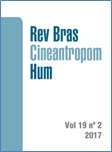Leisure-time physical activity and associated factors in fitness zones
DOI:
https://doi.org/10.1590/1980-0037.2017v19n2p185Abstract
Fitness zones (FZ) are a great alternative to physical activity practice. The aim of this study was verify physical activity practice and associated factors among FZ users of Pelotas. Participants answered a questionnaire containing demographic, socioeconomic, behavioral, health and on the use of FZs. A long version of the International Physical Activity Questionnaire was used to determine the level of physical activity and those who reported at least 150 minutes / week of PA in the leisure time were considered sufficiently active. The study included 323 subjects (65.3% women), mean age 52.5 years, 83.6% white skin color and 61.9% married. Almost half of respondents were overweight (48.0%), 45.8% had high blood pressure, 10.5% had diabetes and 64.4% used medications. About 77.7% of respondents were classified as sufficiently active. Health perception was associated to leisure physical activity, and the better the health perception, the higher the prevalence of sufficient physical activity. Collective programs with participation of Physical Education teacher can contribute to interaction of practitione with the use of fitness zones and increase the level of physical activity of individuals.



